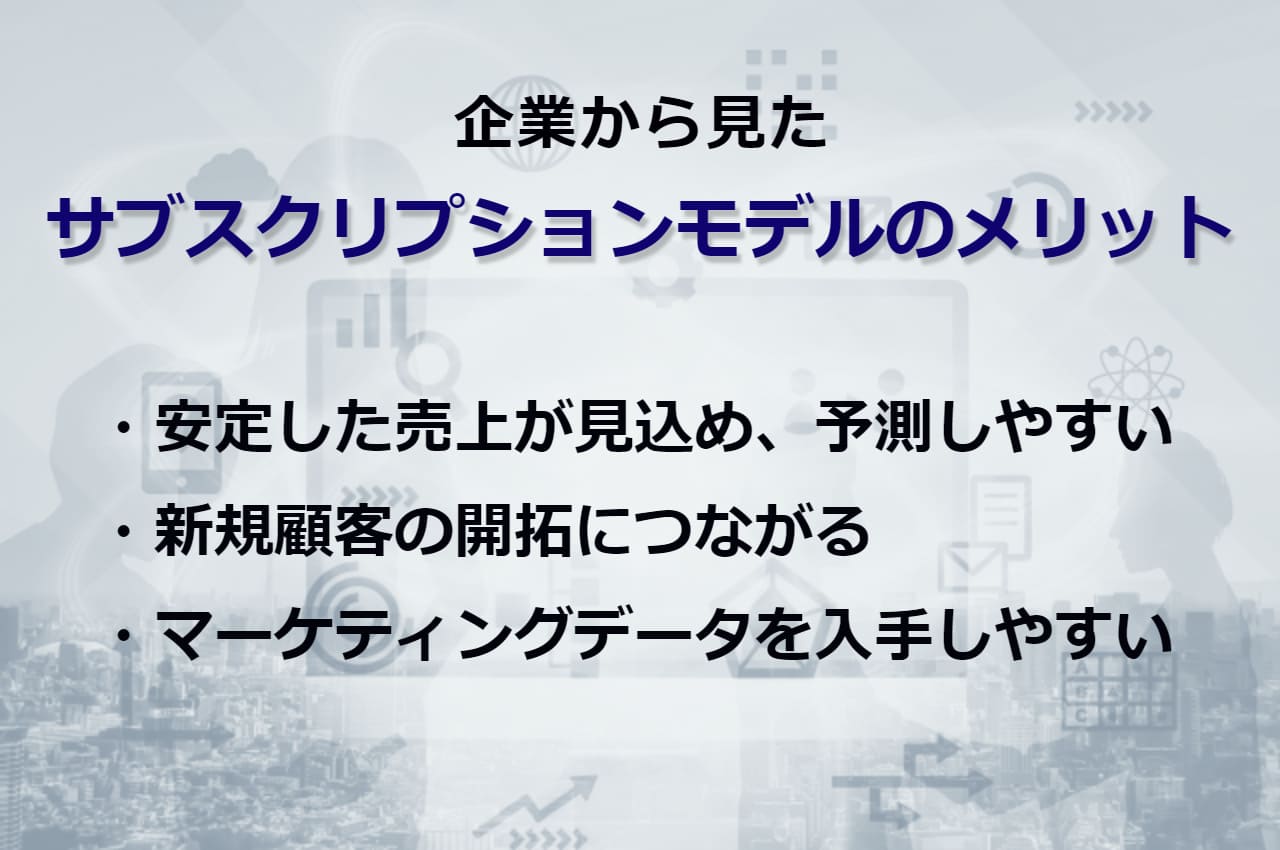サブスクリプションはメリットだけじゃない?注目される課題とは

Last updated: 2020/10/30
Creation date: 2018/10/24
The subscription model is a business model that has many benefits for companies, such as stable profits. On the other hand, some companies are withdrawing from the market, and issues are becoming clearer. As a business consultant, I would like to keep an eye on these trends. We have summarized the benefits and future challenges of subscription services.
table of contents
■The era of subscriptions for cars and beer! The reasons why they are popular among the younger generation are
(1) They are affordable and can be used for as long as you want
(2) People are no longer obsessed with owning things
(3) What are the popular subscription services?
■What are the benefits of the subscription model from a company's perspective?
(1) Expect stable sales and are easy to predict
(2) Lead to the development of new customers
(3) Easy to obtain marketing data
■The subscription business model also has disadvantages
(1) It takes resources to maintain customer contracts
(2) It takes time to lead to stable sales
■What are the current challenges facing subscription services?
(1) AOKI, the suit company, started a subscription service, but it ended after six months
(2) Meal kit subscription services are struggling overseas
*This column has been reorganized from October 30, 2020 on "Subscription services that are appearing one after another."
The era of subscriptions for cars and beer! Why is it popular with the younger generation?
Subscription (flat-rate) services are attracting attention as a new business model. According to an article in CNET JAPAN (*1), “Over the past seven years, subscription company sales in North America, Europe, and the Asia-Pacific region have increased by more than 300%” (article dated July 31, 2019). Subscription services are rapidly growing worldwide.
Subscription services such as Spotify and Netflix are already well established in Japan. Furthermore, companies such as Kirin and Toyota are also making new subscription services available.
subscriptionA subscription service is a business model in which you do not purchase a product or service, but rather pay a fixed amount during the usage period . Why are the number of users of subscription services increasing, especially among young people? Let me introduce two main backgrounds.
(1) You can use it for as long as you want at a reasonable price
Subscription services generally offer unlimited usage for a fixed fee , such as music and video distribution. In other words, the more you use it, the more benefits you get. Also, purchasing software etc. can be expensive, but if you use a flat rate system, the amount you pay each month can be kept low, making it more affordable. You can also stop when you want to stop, so it has the advantage of being cheap when you just want to try it out for a certain period of time .
(2) The obsession with owning things has disappeared.
Recently, there has been a growing sense of not being particular about owning things, especially among young people, and this has also led to an increase in the use of subscription services.It is also called the reason. This is likely due to the influence of the Internet . Novels, music, and movies can now be viewed anytime and anywhere using smartphone apps.
Also, in the past, there was a sense that being successful and buying luxury things was considered status. However, young people these days seem to be less picky about owning things and tend to think that ``it's more efficient to use things only when you want to use them'' and ``if you own things, you'll have trouble finding a place to store them.' ' In line with these trends, subscription services have recently appeared that allow you to rent clothes, watches, furniture, home appliances, etc. for a fixed price.
(3) Which subscription services are popular?
では実際にどんなサブスクリプションサービスが利用されているのでしょうか。マクロミルの調査(※2)によると、利用しているサービスは動画配信が最も多く、音楽配信、本・雑誌・コミック書籍と続きます。その他を見てもニュースやソフトウェア、ゲームなどアプリ系コンテンツ関連がほとんどという状況。しかし「今後使いたいサービス」を見ると、「飲食」「衣料品」「自動車」などのデジタルコンテンツ以外のサービスも上位に入ってきていました。
しかし、この調査の翌年である今2020年、新型コロナウイルスによって世の中は大きく変化しました。“おうち時間”が激増したことにより、衣料品や化粧品などへの需要が下がっていることは周知のとおりです。外出は散歩程度ですませて家の快適化を重視するようになった人が増え、お花の定額アプリ“ハナノヒ”(※3)などのような、生活に潤いをプラスするようなサービスにも注目集まるようになりました。
そのかたわらで、外食やレジャーを筆頭に低迷した産業を支援するGO TOキャンペーンなどが始まり、現在は遠出する人も徐々に増加してきました。モノの消費に対する状況も日々変化しています。
とはいえ、モバイルアプリの普及もあり、サブスクリプションサービスの主流はやはりデジタルコンテンツ。しかし今後利用したいサービスを見ると、リアルなプロダクトを使ったサービスもこれから伸びしろがあることが見えてきます。
たとえばトヨタでは、自動車を定額で利用できるサービス「KINTO」を2019年7月からスタートさせました(※4)。販売に影響が出るという懸念もありますが、他社より先駆けて参入する動きには、戦略の面に大きなメリットもあるはずです。一方キリンは、すでに2017年からサブスクリプションサービス「Home Tap」を始めています(※5)。これはビアサーバーを無償で貸し出し、定期的に工場からビールを直送するというサービス。キリンではこのサービスにて、直販事業(EC)にも取り組み始めました。
☆あわせて読みたい
『【PMOコンサルタントとは】つまらない?意味ない?キャリアに使えない?向いている人と今後の将来性・年収を解説!』
『【ITコンサルタントとは】激務?学歴や資格は必要?未経験からなるには?仕事内容や年収、SIerとの違いを解説!』
企業から見たサブスクリプションモデルのメリットとは?
利用者だけではなく、企業にとってもサブスクリプションモデルはさまざまなメリットがあります。代表的なメリットを3つピックアップしました。
(1)安定した売上が見込め、予測しやすい
プロダクトやサービスを売る場合、月によって売上にバラつきが大きくなることもしばしば。その点、サブスクリプションモデルは定額制のため、毎月一定の売上が見込めます。ある程度安定した売上を見通すことができ、将来の売上予測がしやすいというのは企業にとって大きなメリット。追加投資などの計画も立てやすくなります。
(2)新規顧客の開拓につながる
サブスクリプションモデルは、売り切りと比べて手ごろな金額で利用でき、初期費用もあまりかかりません。つまりハードルが下がるため、新たな顧客の獲得につながりやすい点がメリット。
例えば前述したレンタカーをサブスクリプション化させたようなサービス「KINTO」も、この新規顧客獲得に貢献することが期待できます。自動車をローンで購入するのに比べ、サブスクリプションサービスなら「使いたい期間だけ使える」という気軽さがあります。また、レンタカーのように、利用する度に手続きをする手間もありません。車離れが進んでいると言われる若年層や、なかなか車を所有しづらい転勤の多い人など、従来とは異なる顧客をターゲットにしているようです。
(3)マーケティングデータを入手しやすい
サブスクリプションモデルには、マーケティングデータとしての活用側面もあります。
サービス申込時には一定の情報を入力する必要があるため、マーケティングに必要な顧客情報を入手しやすいと言えます。また継続利用が前提のため利用動向データも得られます。こうしたマーケティングデータを他の事業に活用できるという点は、企業にとって大きなメリットでしょう。
サブスクリプションのビジネスモデルにはデメリットもある
メリットに注目が集まっている一方、サブスクリプションモデルのデメリットもおさえておきたいところです。
(1)顧客の契約維持のためにリソースがかかる
売り切り型のビジネスモデルと比べて、サブスクリプション化したビジネスは、顧客維持に手間がかかる点がデメリット。サブスクリプションサービスは気軽な分、解約されやすいのも特徴のひとつなのです。解約を防ぐには継続したプロモーションを導入したり、サポートの充実を図る必要があります。
また利用者対応に手間がかかるため、契約数が一気に増えると運用できなくなる可能性もあります。例えば前述したキリンのビール定額制サービス「Home Tap」は、開始当初申し込みが殺到したため、一旦受付を停止せざるを得ませんでした。
(2)安定した売上につながるまでに、時間がかかる
サブスクリプションモデルは、安定した売上が見込めるというメリットがある一方、サービスや商品の開発、在庫準備などかかった投資費用の回収に時間を要します。資金の少ないスタートアップ企業は特にこの点は大きなデメリットでしょう。例えば洋服のサブスクリプションサービスを運営する「メチャカリ」も、サービスを始めた3年後にようやく黒字化が見えてきたと言います(※6)。
サブスクリプションサービスが今抱える課題とは
Many companies are entering subscription services in Japan, but the reality is that there are still not many successful companies. Some companies are struggling with high churn rates, while others are quietly withdrawing from subscription services. As a consultant, I think you would want to understand what the problem was from these cases. Therefore, we have summarized the issues currently facing subscription models based on cases in Japan and overseas.
(1) Suits AOKI started a subscription service, but ended it after six months
In 2018, AOKI launched a new service called ``suitsbox,'' which offers suit rental as a subscription service . However, six months later, this service was discontinued. It is rare for a case to be completed in such a short period of time. It seems that the change in management policy due to the change of president had an impact, but it also seems to be true that there were issues with the "Suitsbox" service.
According to an article in Nikkei Crosstrend, reasons why Suitsbox did not work out include such things as ``the service operation costs were high'' and ``the customers were almost the same age as the store users'' (* 7). Especially when dealing with the rental of real products such as suits, inventory management and shipping costs are unavoidable. On the other hand, monthly fees should be kept low. Setting rates, reducing operating costs, and improving efficiencyStreamlining will be a major issue for future subscription services.
AOKI's store users are mainly men in their 40s, but the subscription service was targeted at men in their 20s and 30s . However, in reality, subscriptions, like stores, were mainly used by people in their 40s , and they did not seem to be able to attract new customers . It can be assumed that the original aim was to use the subscription service as an opportunity to discover new customers and lead to sales.
Looking at the case studies of companies like AOKI that handle sales, it can be said that the major challenge is how to balance sales and subscription businesses, and how to create synergistic effects .
(2) Meal kit subscription services are struggling overseas
Just like in Japan, there seem to be cases overseas where subscription services are struggling. For example, services related to meal kits (a meal kit is a product in which a set of prepared ingredients is delivered to the user's home and the user can prepare a meal according to the recipe). Blue Apron, an American company that provides a meal kit subscription service, is another company that is struggling (*8).
According to a news article, the number of Blue Apron users as of the end of 2018 was 189,000 fewer than the previous year. Reasons for many cancellations include ``it's not easy to use because it has conditions such as ordering XX times a week'' and ``there aren't many food options.' '
Looking at the case of Blue Apron, it can be said that ease of use and flexibility of response are highly important for subscription services that assume continuous use .
However, the new coronavirus has exerted a tailwind effect, and Blue Apron's stock price rose approximately 70% from the previous day's closing price on March 17, 2020, making it difficult to predict the future under unprecedented circumstances. It is also true (*9).
Subscription services are rapidly expanding around the world. In addition to the examples introduced in this article, more and more companies are adopting subscription models in all industries. As a result, competition is intensifying, and market share can change rapidly.
Now that remote work is rapidly gaining popularity, and there is a trend that even offices are no longer necessary, we may be moving further away from "things" and accelerating the era in which sharing is the norm.
<Reference>
*1: https://japan.cnet.com/article/35140356/
*2: https://honote.macromill.com/report/20190425/
*3: https://www.hibiyakadan.com/ shop/hananohi
*4: https://kinto-jp.com/
*5: https://hometap.kirin.co.jp/
*6: https://markezine.jp/article/detail/31583
*7: https://xtrend.nikkei.com/atcl/contents/casestudy/00012/00105/
*8: https://digiday.jp/brands/blue-apron-hemorrhaging-subscribers-expands-retail-partnerships-strategy/
* 9: https://forbesjapan.com/articles/detail/33148
(Mirai Works Co., Ltd. FreeConsultant.jp Editorial Department)







